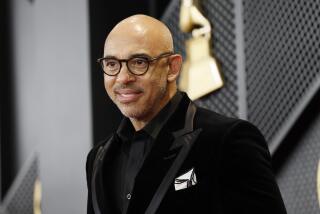The Big Picture: New leader probably won’t change much in academy
The best thing you can say about the Academy of Motion Picture Arts and Sciences is that it’s impossible to imagine it ever being investigated for campaign finance violations. While our two political parties are expected to each spend nearly a billion dollars in negative advertising to elect a president this November, the academy’s upcoming presidential election proceeds with polite, almost quaint, rules.
Next Tuesday, someone will be named as the academy’s new president, succeeding Tom Sherak, who is termed out after three productive years as chief. But not a dime will be spent on attack ads — in fact there hasn’t been any visible campaigning.
When the academy’s new Board of Governors meets it will vote by secret ballot, until one candidate wins the support of more than 50% of the 43-person board. No one has announced their candidacy, since it is considered bad form to lobby for votes.
SPECIAL REPORT: inside the Academy
The leading candidate is Hawk Koch, a veteran producer who has brought new respectability to the Producers Guild in his role as co-president. His biggest rival is probably Rob Friedman, who after presiding over the “Twilight” hits at Summit Entertainment, is now co-chairman of Lionsgate. Koch is a big supporter of the below-the-line crafts; Friedman would offer a strong managerial presence.
Would either man shake up the academy? I doubt it. Would one of them gently push it in a new direction? Maybe. Koch and Friedman are solid candidates, Hollywood veterans with proven track records. But perhaps a bolder choice is in order. Today, with the studios run by largely colorless corporate executives, the academy presidency is one of the rare showbiz platforms where someone can serve as an advocate for change — and the academy is certainly in need of it.
The academy presidency is one of Hollywood’s few remaining high-profile jobs even if much of the actual power rests with the Board of Governors. In earlier times, the movie studios were full of charismatic, larger-than-life moguls — such as Sam Goldwyn and Jack Warner — who symbolized the industry’s irrepressible energy and exuberance. In more recent times, Hollywood was represented by potent power brokers such as Universal’s Lew Wasserman and the MPAA’s Jack Valenti.
GRAPHIC: And the Academy members are...
Unfortunately, innovation isn’t the academy’s strong suit. The odds of the academy electing a radical reformer are about as slim as “Ted”being nominated for best picture. Good things do happen in Academy Land: The organization recently inked a rich new TV contract that will keep the Oscar broadcasts on ABC through 2020 and has teamed up with the Los Angeles County Museum of Art for a new film museum.
But younger industry-ites remain frustrated by how little the institution has managed to get its arms around the sleek new visual-effects extravaganzas that fill movie theaters around the globe. Even though most of the creative advances in technology and storytelling are going into films like “The Dark Knight Rises,” “The Avengers”and Pixar and DreamWorks animation films, the academy still lavishes most of its best picture statuettes on stately, highbrow dramas.
Diversity is still an issue. I was almost embarrassed to find myself giddily cheering the academy a few weeks ago when it actually invited a few people of color and some prominent international filmmakers as new members. Even Dawn Hudson, the former Film Independent head who was brought in as the academy’s chief executive in 2011 to shake things up, has found it hard to nudge the older white male dominated academy into the modern, multicultural world.
INVITEES: The who’ve joined the Academy since 2004
Nothing would serve the organization better than to have a brash transformational figure — think Mark Cuban or Ari Emanuel — as its new president. But neither Cuban, who owns Landmark Theatres, nor Emanuel, who heads the William Morris Endeavor talent agency, is eligible to even serve on the board; Cuban isn’t an academy member and Emanuel isn’t allowed to vote, since agents can be only associate members.
The true seat of power lies with the Board of Governors, not the president; without board approval, it’s impossible for the academy to achieve any dramatic change. It would be a huge shot in the arm to the Oscars telecast if some of the technical awards — starting with such categories as short films and sound editing — could be given out at a separate event, freeing up valuable airtime for something fresh or different, like Olympics-style documentary clips about the more intriguing or colorful nominees.
But the way the board is constituted, with three representatives from nearly every branch of the academy, it’s hard to imagine that happening. The technical branches have one another’s backs; the costume designers and art directors will always protect their sound editing brethren’s slot on the broadcast.
Individually, the board members, who include such prominent figures as Tom Hanks and Kathryn Bigelow as well as such lesser-known talents as cinematographer John Bailey and animator Bill Kroyer, are thoughtful people. But as a body, they are totally out of touch with the pop culture zeitgeist.
For an organization that represents one of the few visible connections between the industry and a youthful generation of moviegoers, the board has the musty odor of an insider’s club. It boasts only one African American and only eight women. So while the younger generation of tech wizards in Silicon Valley have been revolutionizing the way we process information and access entertainment, the academy has remained a bastion of old-school thinking. And to hear academy insiders tell it, the new president will almost certainly be a keeper of tradition, not a game changer.
The history of Hollywood is full of visionaries, restless artists who’ve constantly pushed the envelope in terms of creativity and technical prowess. It’s time the academy embraced that innovative spirit inside its own hallowed walls.
Twitter: @patrickbigpix
ALSO
Hollywood legend Dick Zanuck: a princeling who earned his stripes
More to Read
Only good movies
Get the Indie Focus newsletter, Mark Olsen's weekly guide to the world of cinema.
You may occasionally receive promotional content from the Los Angeles Times.










